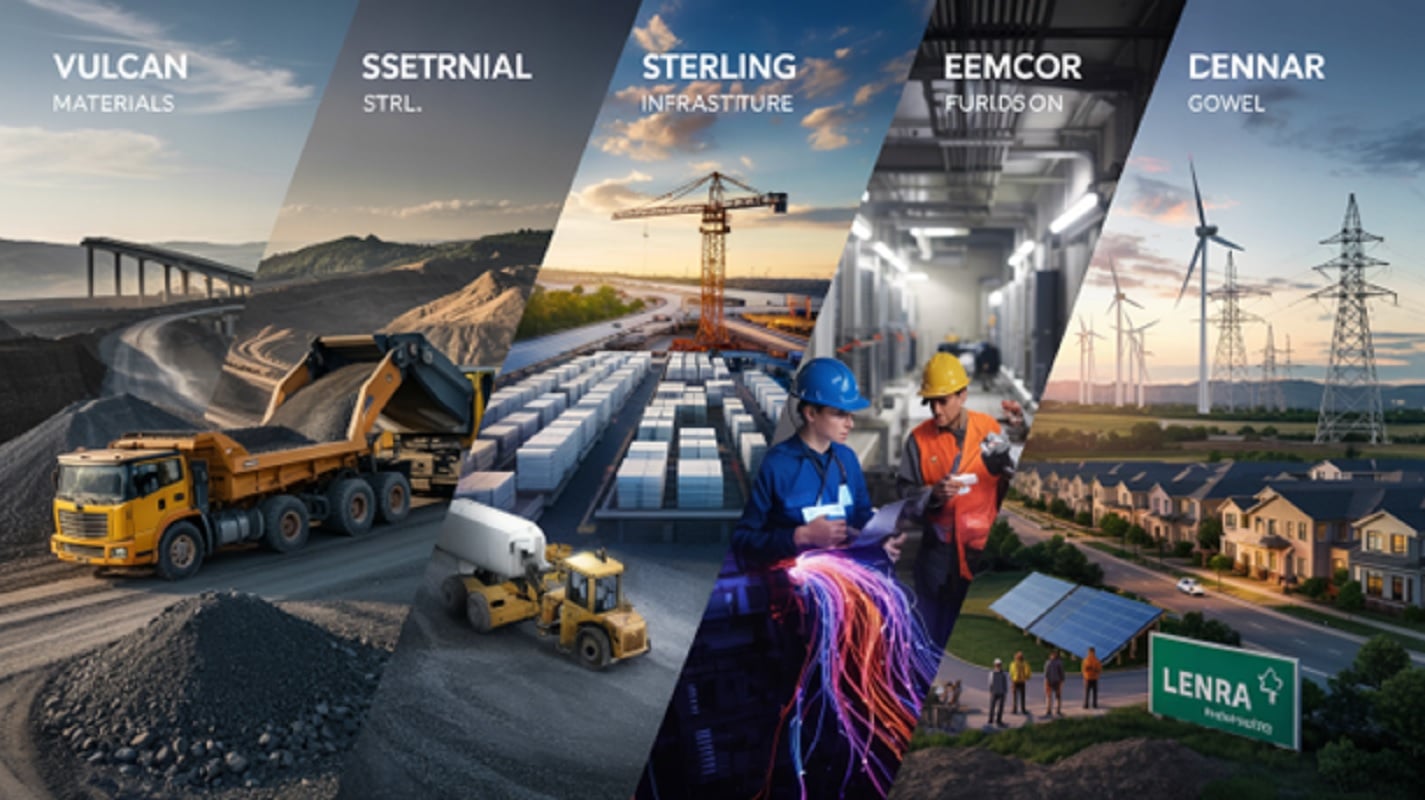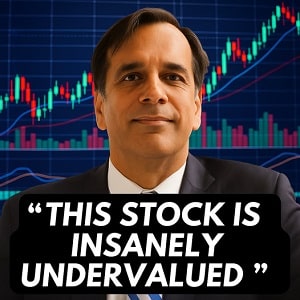Finding good investments feels like navigating a maze sometimes, especially in a sector as fundamental yet complex as construction. Heading into 2025, the U.S. construction scene is definitely a mixed bag – picture a building site with brand new cranes working alongside some older, rustier equipment.
So, how does an investor make sense of it all? It comes down to picking companies that are well-positioned to ride the positive waves while hopefully weathering the storms.
We’ve dug into the different corners of the industry – from the folks digging up rocks to the ones wiring up data centers and building homes – to identify five U.S. construction-related stocks that look particularly interesting for 2025. Remember, though, this isn’t financial advice – just analysis to get you started. Always do your own homework before investing!
1. Vulcan Materials (VMC): The Foundation Provider
- What They Do: Think of Vulcan Materials as the company supplying the literal building blocks. They’re the biggest U.S. producer of construction aggregates – that’s the crushed stone, sand, and gravel essential for concrete, asphalt, and laying foundations. They’re also big in asphalt and ready-mix concrete. With quarries and distribution centers dotted across the country, they’ve got serious scale.
- Why They Look Interesting for 2025: Infrastructure projects gobble up aggregates, making Vulcan a direct beneficiary of the IIJA funds hitting the ground. If America is rebuilding roads and bridges, they need Vulcan’s rocks. What’s impressive is their pricing power – they’ve managed to raise prices and boost margins even when costs were climbing elsewhere. That suggests a strong market position.
Looking ahead to 2025, they’re anticipating continued price strength (expecting 5-7% aggregate price hikes) and decent shipment growth (3-5%), partly thanks to public projects and smart acquisitions like Superior Ready Mix Concrete. They’ve also consistently raised their dividend, which income investors appreciate. Most analysts seem to be leaning positive on the stock heading into the year.
2. Sterling Infrastructure (STRL): Riding the Tech & Transport Waves
- What They Do: Sterling Infrastructure isn’t just a road builder. They operate in three main areas: E-Infrastructure (think massive site prep for data centers, EV factories, e-commerce hubs), Transportation (your classic highways, bridges, airports), and Building Solutions (concrete foundations).
- Why They Look Interesting for 2025: Sterling is hitting two sweet spots hard. Their E-Infrastructure division is booming thanks to the insatiable demand for data centers (hello AI!) and the push for domestic high-tech manufacturing. They snagged huge contracts recently, like work for Hyundai’s EV facility. At the same time, their Transportation arm is perfectly positioned to grab IIJA-funded projects – they recently won a big highway job in Utah.
Even though analysts predict a slight dip in overall revenue for fiscal 2025, they expect earnings per share to jump significantly (over 34%!), which points to strong profitability. The company started 2025 with a healthy $1.83 billion backlog, giving them good visibility. After a huge run-up in the stock price over the last decade, a recent pullback might present a more reasonable entry point (forward P/E was noted around 18x recently).
3. EMCOR Group (EME): Wiring Up the Future
- What They Do: EMCOR specializes in the complex guts of buildings and infrastructure – primarily mechanical and electrical construction. They’re the ones handling the intricate systems needed for data centers, chip factories, hospitals, power plants, and other advanced facilities. They also provide ongoing facilities services.
- Why They Look Interesting for 2025: EMCOR is right in the thick of several major trends. The data center buildout requires exactly the kind of complex electrical and cooling systems EMCOR provides. The reshoring of manufacturing, especially high-tech facilities like semiconductor plants, is another huge tailwind. Plus, general infrastructure upgrades (energy grid, industrial facilities) play to their strengths.
Their backlog is impressive ($10.1 billion at the end of 2024, up significantly year-over-year), meaning they have a lot of work already lined up. Their recent acquisition of Miller Electric further boosts their capacity in hot areas like data centers. Analysts have been positive, upgrading earnings estimates, and the company has a strong financial track record.
4. Quanta Services (PWR): Powering the Transition
- What They Do: Quanta is a giant in specialized contracting, focusing on the infrastructure that keeps the lights on and data flowing. Think electric power transmission and distribution, renewable energy projects (wind, solar), natural gas pipelines, and communications infrastructure (like broadband).
- Why They Look Interesting for 2025: Quanta is plugged into some powerful, long-term shifts. Modernizing the aging U.S. electric grid is a massive undertaking. The transition to renewable energy requires huge investments in new generation and transmission lines. Expanding broadband access is another national priority.
Quanta is a key player in all these areas, likely benefiting from both the IIJA and the Inflation Reduction Act (IRA). They boast an enormous backlog ($34.5 billion total at end of 2024), giving them excellent visibility into future work. Management is confident, guiding for double-digit growth across the board (revenue, earnings, EBITDA) in 2025. They also have a good history of beating earnings expectations.
- What They Do: Lennar is one of the heavyweights in American homebuilding. They build everything from starter homes to communities for active adults, operating across 26 states. Beyond just building, they have divisions for mortgages (Financial Services), apartment development (Multifamily), and even tech investments.
- Why They Look Interesting for 2025: Housing is tricky, but Lennar could be positioned interestingly. If mortgage rates finally ease up later in 2025, as many hope, it could unleash a wave of buyers who’ve been stuck on the sidelines.
Fundamentally, there’s still a housing shortage in the U.S., and Lennar, as a market leader, is set to meet demand. They’re also making smart strategic moves, shifting to an “asset-light” model by controlling more land through options rather than owning it outright (via their Millrose spin-off and Rausch Coleman acquisition). This should reduce risk and potentially boost returns. They have a strong balance sheet with plenty of cash, giving them resilience, and they actively return cash to shareholders through buybacks.
Comparative Snapshot: Top 5 Construction Stock Ideas for 2025
| Ticker | Company Name | Key Market Exposure | Key 2025 Strength Driver(s) | Key 2025 Risk(s) |
| VMC | Vulcan Materials Co. | Aggregates, Infrastructure (IIJA), Non-Res | IIJA Spending, Pricing Power, Aggregate Demand | Cyclicality, Private Construction Slowdown, Rates, Mexico Ops Issue |
| STRL | Sterling Infrastructure Inc. | E-Infrastructure (Data Centers, Mfg.), Transport (IIJA) | Data Center Boom, IIJA Funding, Strong Backlog | FY25 Revenue Dip, Project Dependence, Labor/Materials Costs |
| EME | EMCOR Group Inc. | Electrical/Mechanical E&C, Data Centers, Mfg. | Data Center/Mfg Demand, Backlog Growth, Acquisition | Margin Sustainability, Slowing Revenue Growth, Specialized Labor |
| PWR | Quanta Services Inc. | Utility/Energy Infra, Renewables, Communications | Grid Modernization, Renewables (IRA), Backlog | Valuation Premium, Renewables Policy Risk, Execution, Labor |
| LEN | Lennar Corp. | Homebuilding (Broad Range) | Potential Rate Easing, Housing Demand, Asset-Light Shift | Rate Sensitivity, Affordability, Margin Pressure, Cyclicality |
Wrapping It Up: Building Your Own View
The US construction sector in 2025 is clearly a tale of different stories. You’ve got the undeniable boost from government infrastructure cash and the tech-driven demand for data centers creating real bright spots. But you also have the ongoing struggle with finding workers, unpredictable material costs, and the big question mark over interest rates affecting housing and private development.
The five companies we looked at – Vulcan, Sterling, EMCOR, Quanta, and Lennar – offer different ways to potentially play these trends.
Vulcan provides the essential materials, Sterling hits the hot data center and transport markets, EMCOR wires up complex facilities, Quanta powers the energy transition, and Lennar navigates the challenging but crucial housing market.
There’s no single “best” stock here; each comes with its own set of opportunities and risks. The key takeaway? Investing in construction requires looking beyond the headlines. Dig into the specific markets these companies serve, understand their backlogs and strategies, and weigh the potential rewards against the very real risks. As always, make sure any investment fits your own financial situation, timeline, and how much risk you’re comfortable taking. Good luck!
Frequently Asked Questions (FAQ)
Is the big infrastructure bill (IIJA) really making a difference for construction stocks in 2025?
It definitely seems to be. After a slower start, reports suggest that IIJA money is increasingly flowing to actual projects – think roads, bridges, water systems, broadband. This creates a solid pipeline of work, especially for companies in heavy civil construction (like STRL), materials (like VMC), and specialized E&C firms (like EME and PWR). While the peak spending might still be a year or two away, 2025 is expected to see a significant positive impact from these funds.
What are the biggest worries for construction companies and their stocks this year?
The top headaches remain consistent: finding enough skilled workers (which pushes up labor costs), the potential for material prices to jump again (especially with talk of new trade tariffs), and what happens with interest rates. Higher rates make it more expensive to finance projects and can slow down private sector work, especially housing. There’s also general uncertainty about economic direction and specific government policies.
Construction seems like it goes up and down with the economy. Are these stocks okay for long-term investing?
That’s a fair point – construction is cyclical. It tends to boom when the economy is strong and slow down during recessions. However, that doesn’t mean they can’t be good long-term holds. Underlying needs like housing, infrastructure repair, and now, the energy transition and data center buildout provide ongoing demand. Keys for long-term investors are to choose companies with strong finances that can weather downturns, understand the cycles, maybe diversify across different types of construction stocks, and have a long enough time horizon to ride out the bumps.
How much do interest rates really matter for these stocks?
They matter quite a bit, but differently across the sector. Homebuilders like Lennar are very sensitive because higher mortgage rates directly hit buyer affordability and demand. Companies doing private commercial projects also feel the pinch as financing gets more expensive. Infrastructure work funded by government programs (like IIJA) is generally less directly sensitive to rate hikes, but the overall economic environment shaped by interest rates still plays a role in project timing and state/local budgets.

































